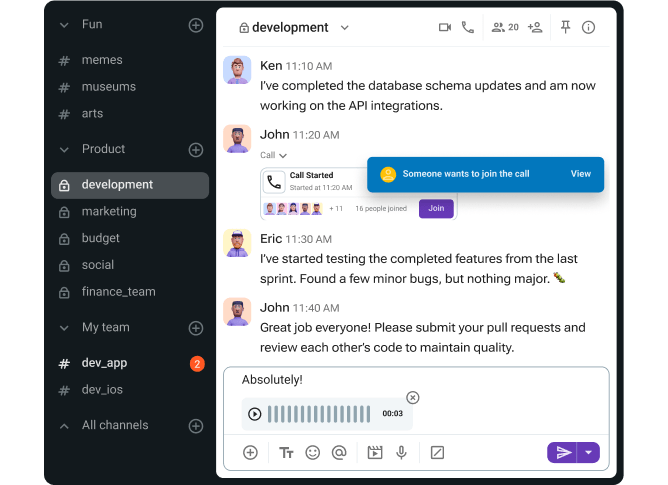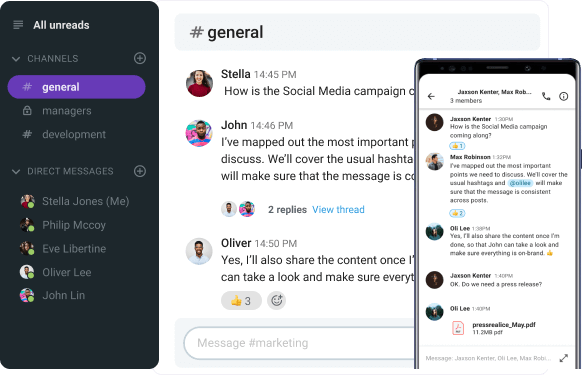Work hard and you will succeed. You’ve probably heard that a million times before. All you have to do to get somewhere in life is put in the effort, right?
But, is that really always the case?
What happens when your efforts get overlooked because you’re not in the habit of fraternizing (or should we say sucking up) to your boss?
If you think you’ve overcome the issue of not being the teacher’s pet when you finished high school, think again — favoritism in the workplace is just as prevalent and can create a whole set of problems.
That’s why today, we’re diving deep into the topic of favoritism at work.
Let’s dig in!

Table of Contents
Favoritism at work: Definition and examples
Favoritism in the workplace happens when one person gets unfair preferential treatment based on personal relationships rather than professional performance.
So, your boss’ bestie getting the promotion your entire team has been gunning for just because they are friends is an excellent example of favoritism at work.
Here’s another one — the favorite employee being fashionably late for work every day suffering no consequences, while the rest of the team gets written up for every minute after 9 a.m.
A workplace favoritism study revealed that 47% of American employees believed their supervisors had favorites that received preferential treatment.
But, it’s not just managers and leaders who have favorites — favoritism at work can happen on any level. Team members can exhibit favoritism by creating team silos and only sharing information with people they’re friends with, unfairly distributing tasks amongst themselves, etc.
Take a look at the Pumble exchange below, which illustrates what team interactions might look like when you’re not the favored employee.
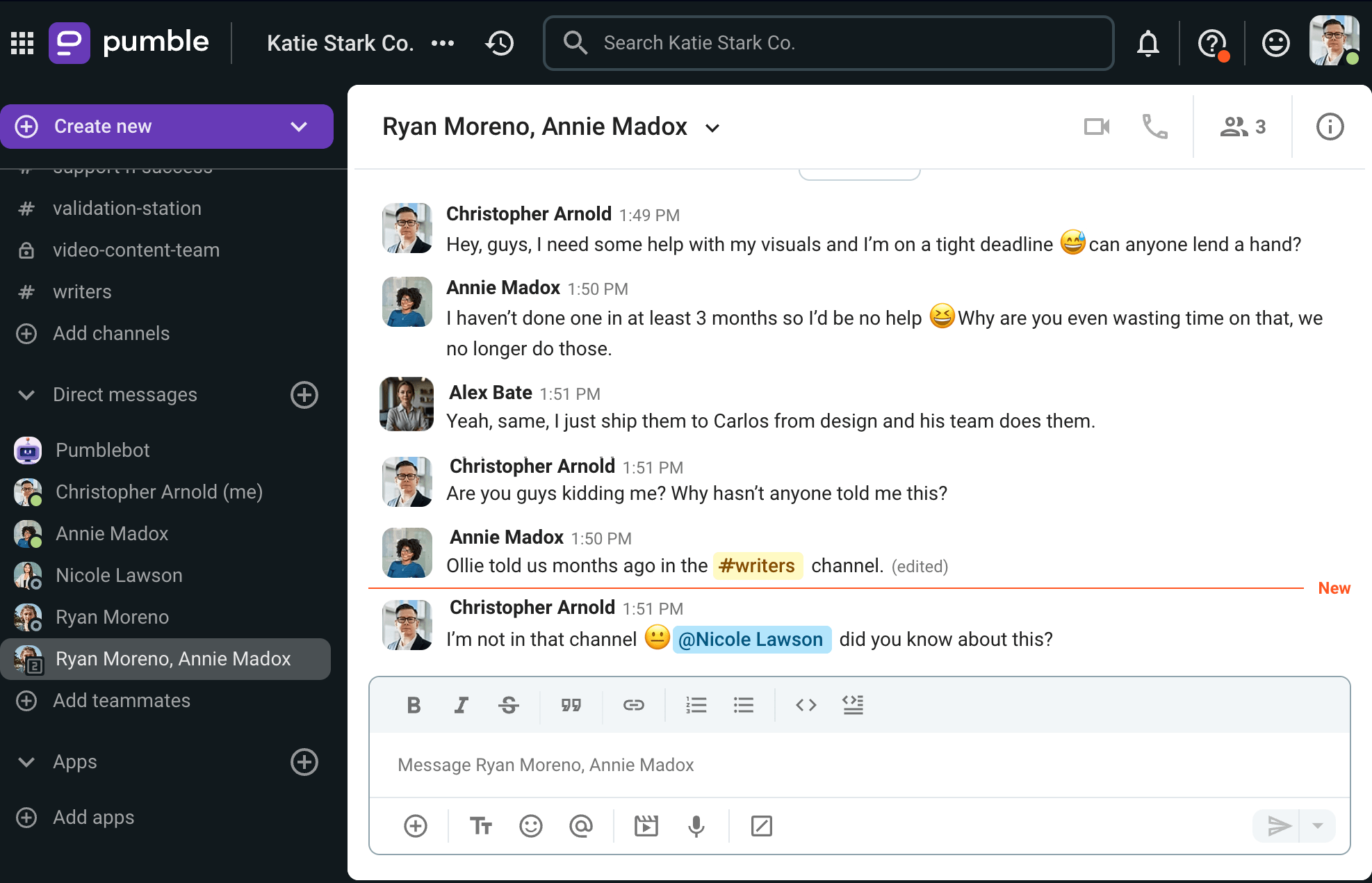
Build a healthy workplace environment with Pumble
One saving grace here is that favoritism often happens unknowingly. People might not realize they’re playing favorites until someone points it out, as our expert contributor, Eva Chan, Senior Career Coach and CPRW, noted.

“Favoritism often occurs because of unconscious bias. Managers may naturally gravitate toward people they personally like or who share similar traits, without realizing how this affects their decisions. Favoritism often starts getting noticeable when it becomes a talking point among several employees.”
Still, conscious or not, playing favorites in the workplace can have some dastardly consequences.
But, before we dig into those, let’s take a look at the different types of preferential treatment in the workplace.
Common types of favoritism in the workplace
So, we already established that there are 2 different types of favoritism at work — manager-employee favoritism and favoritism among peers.
But, overall, we can group different instances of favoritism into 4 distinct types that have to do with:
- Career development opportunities — Favored employees are more likely to get promotion opportunities, guidance, and references.
- Assignments and tasks — Favored employees or team members often get special assignments, more lenient deadlines, and more assistance and information.
- Double standards — Reflected in favorable treatment when it comes to absenteeism and poor performance.
- Unfair treatment or consequences and exclusive behavior — Favored employees often get more perks such as first pick for vacation time, PTO, or tasks, and the benefit of the doubt (when others don’t).
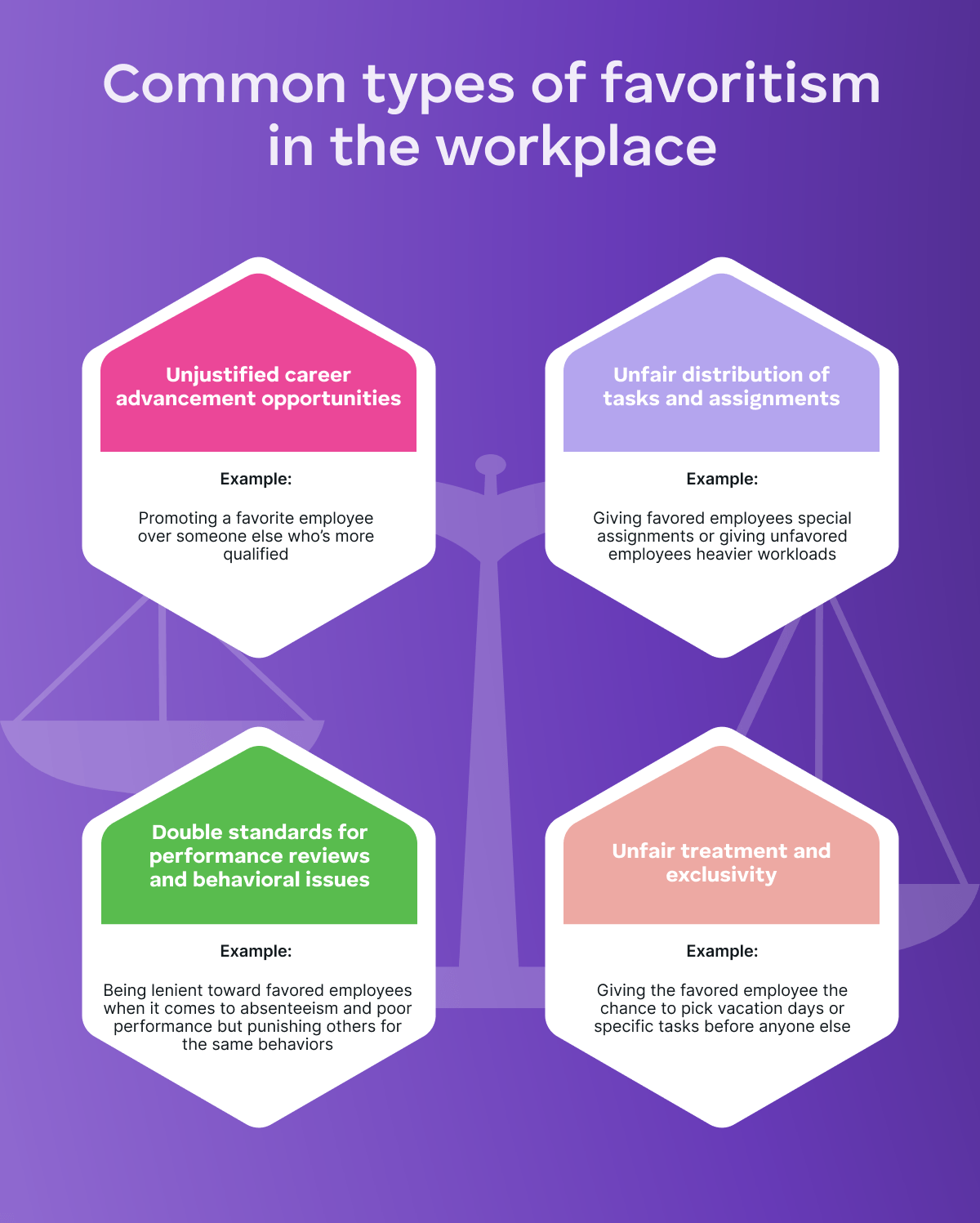
How to recognize favoritism at work
Recognizing favoritism in the workplace isn’t that hard — provided you’re not the favored employee or the person who’s unjustly favoring someone, as noted by Alisa Volynets, HR Business Partner:

“Unfortunately, favoritism can often creep into the workplace and is not always easy to spot. It can manifest itself in small, day-to-day decisions such as a manager giving certain people better projects, pay raises, or bonuses for no apparent reason. The danger is that even the manager may not realize until the last moment that they are favoring a particular employee.”
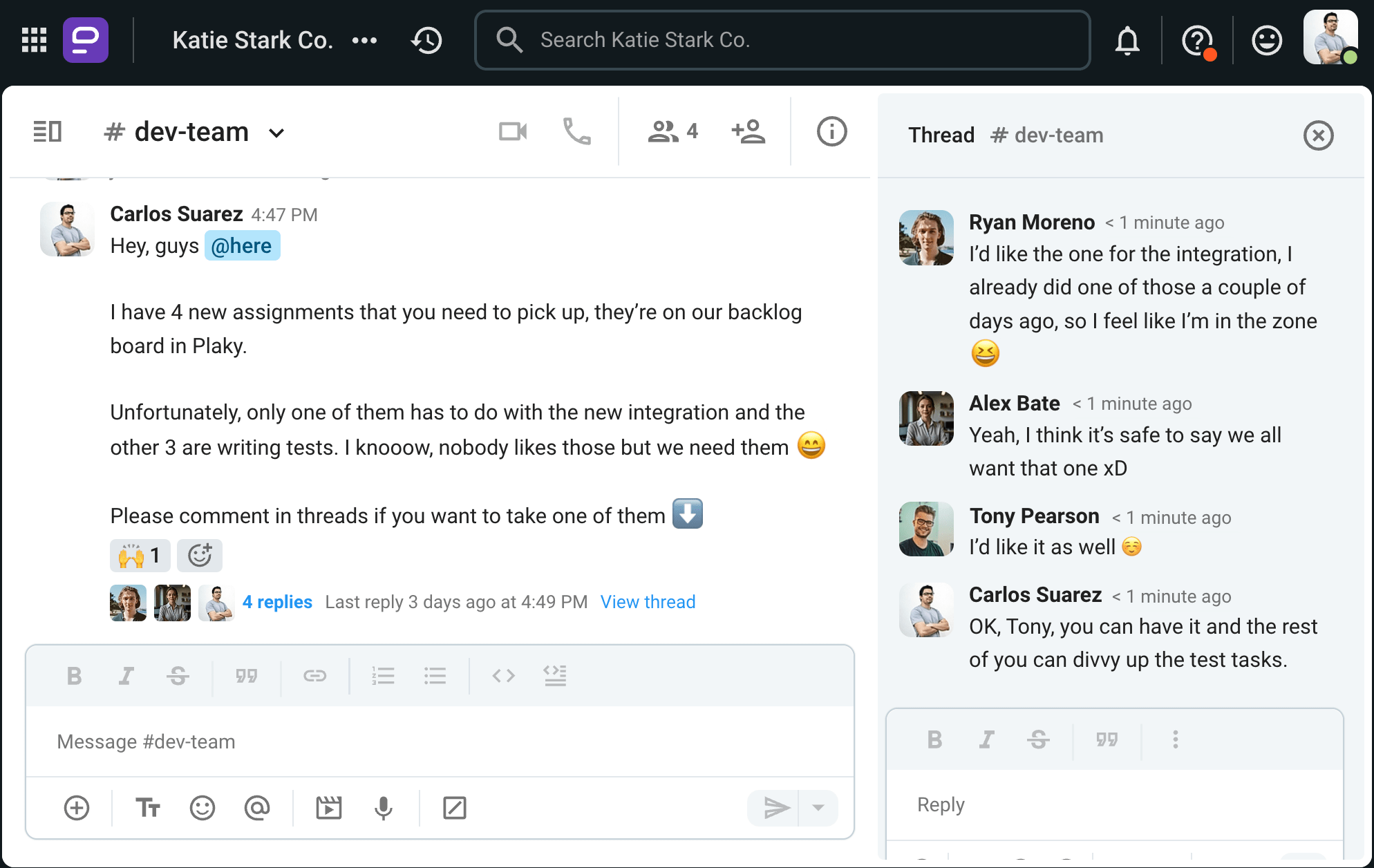
The main sign of favoritism is often inequity, as testified by our expert contributor, Edel Holliday-Quinn, Organizational Psychologist:

“Favoritism can often be identified through consistent patterns of inequity. Look for signs such as certain employees repeatedly receiving better opportunities — promotions, high-profile projects, or access to resources, regardless of merit.”
Of course, handing out undeserved promotions isn’t the only sign to be on the lookout for — some of them might be more subtle than that, as Edel Holliday-Quinn told us:

“Uneven recognition, where one individual is frequently praised while others’ contributions go unnoticed, is another red flag. Favoritism might also show up in social dynamics, such as exclusive access to key meetings or decisions, leaving others feeling excluded.”
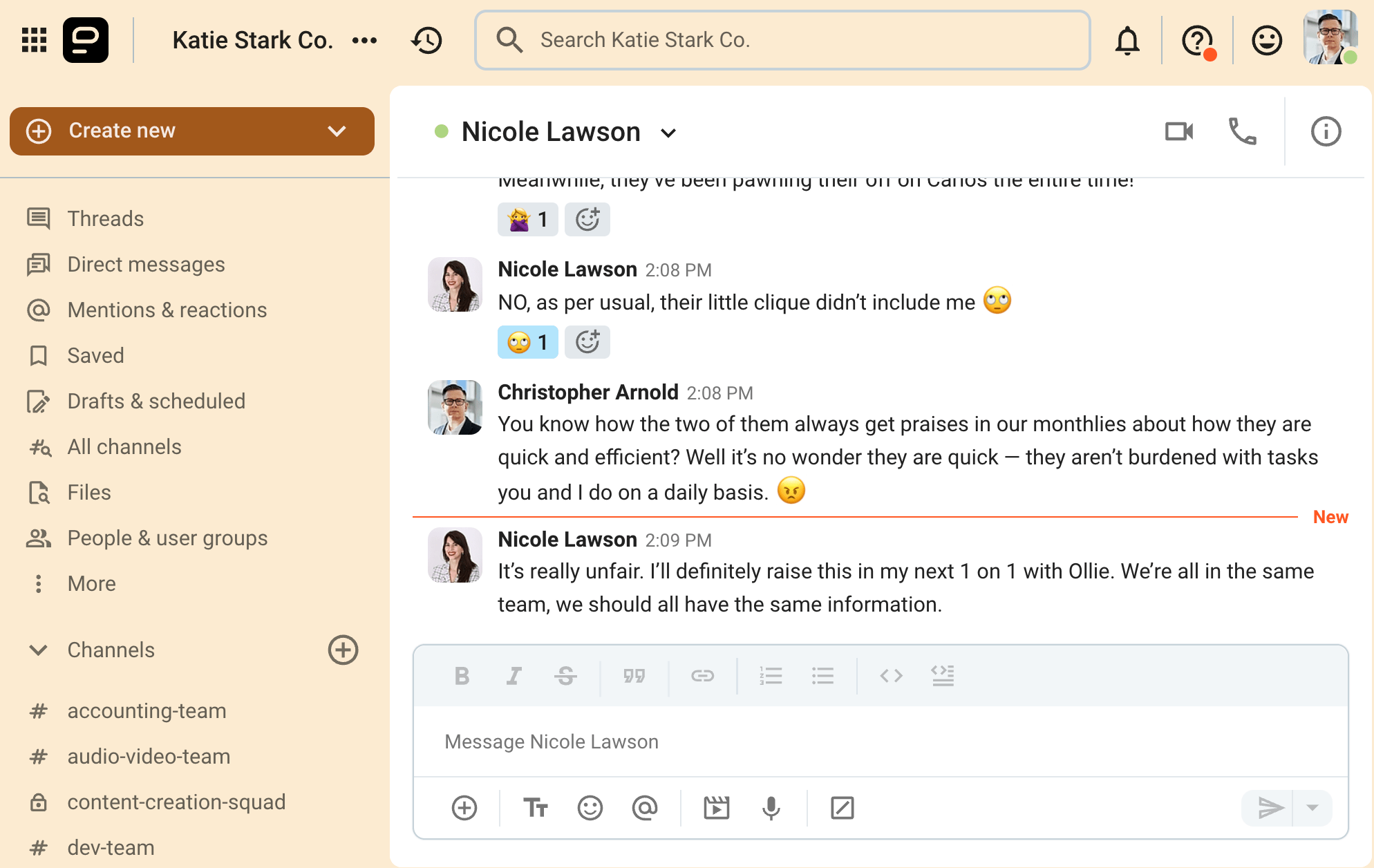
Discrimination or favoritism at work: How to tell the difference
Both favoritism and discrimination are prevalent in the workplace.
A survey of 303 US executives revealed that over 50% of them admitted to having a favorite employee when making promotion decisions.
Meanwhile, 61% of Americans say they have been discriminated against at work, while 48% of young employees say they’ve experienced discrimination when they tried to enter the workforce.
But, while favoritism is about giving preferential treatment to people we like — often those who are similar to ourselves — discrimination is about being hostile to a specific group of people.
However, favoritism can become discrimination if it crosses into illegal territory (in other words, if it’s based on protected characteristics such as race, gender, age, disability, etc.).
So, if your manager is offering Tony more opportunities than you because they have similar interests, that’s favoritism. But if Tony gets more opportunities because he’s a man and you’re not or because he’s white and you’re not, then we’re talking about discrimination.
Effects of favoritism
Favoritism in the workplace has long-lasting results — not only for the individuals but also for the organization as a whole.
The most noticeable (and damaging) effects of favoritism are:
- Toxic culture,
- Low morale,
- Low productivity,
- Conflict and resentment,
- Loss of trust and respect, and
- High turnover.
It’s important to note that the effects of favoritism are all connected and stem from one another, as our contributor, Edel Holliday-Quinn, told us:

“The consequences of favoritism are significant and far-reaching. It damages morale and engagement, as employees who feel undervalued may disengage, reducing productivity. This makes trust within teams erode, leading to strained relationships and lower psychological safety, which is critical for innovation and risk-taking.”
Let’s take a more detailed look into each of the effects of favoritism in the workplace.
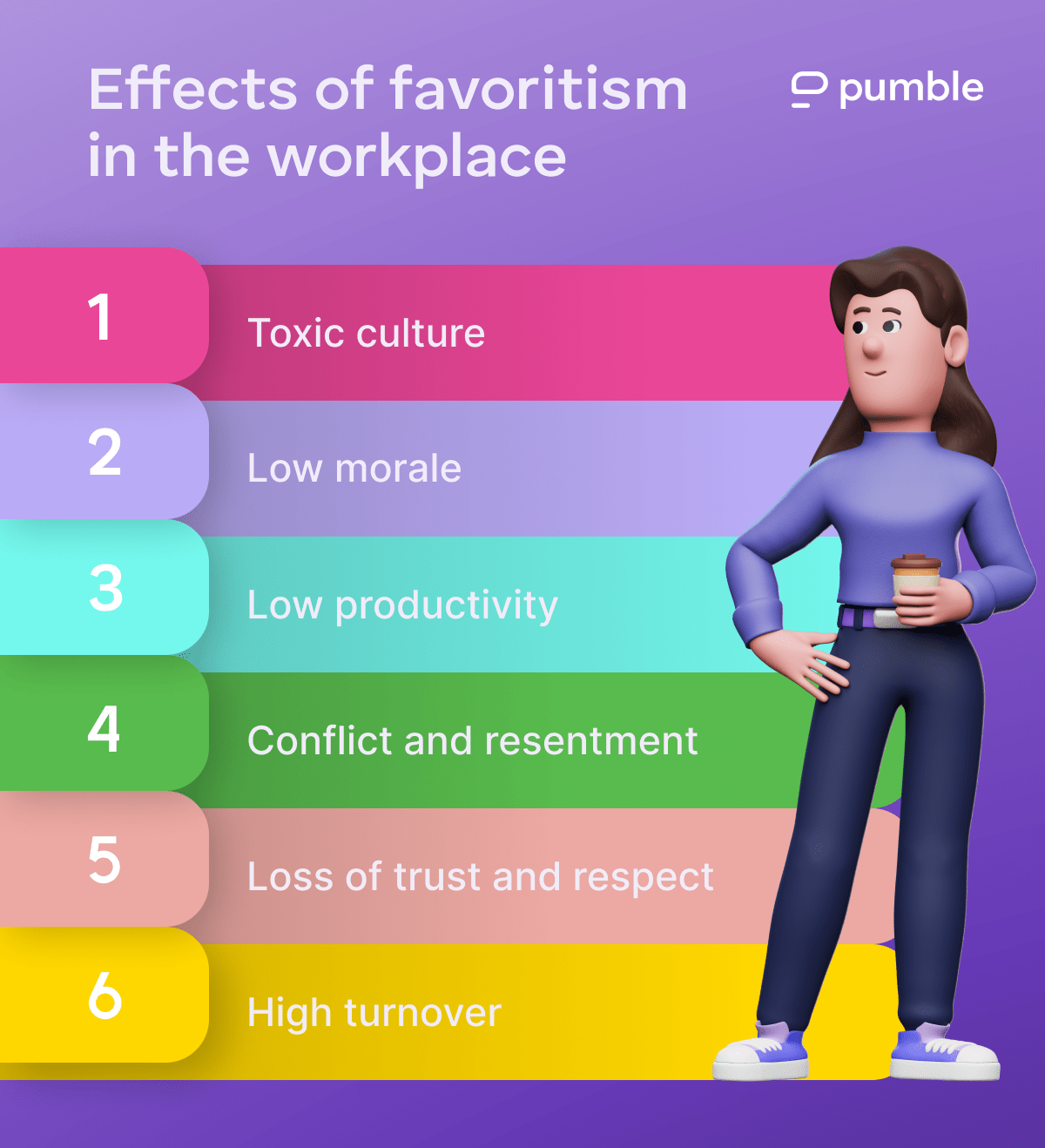
Toxic culture
If you’re a manager, you might think that promoting someone you’re comfortable with — regardless of their skills and expertise — is a good move. After all, it will make your workdays easier, right?
Yeah, sure, but it will also make everyone else uncomfortable.
Clearly favoring one or a few employees over others can create a toxic work environment, as it demotivates employees and makes them lose trust in leadership, as our expert, Alisa Volynets, told us:

“When people feel that their hard work and results are being ignored in favor of someone’s personal relationship with the boss, it leads to resentment and alienation. This reduces overall productivity, as the team becomes less motivated. Such negative processes within the company lead to the creation of a toxic environment where competition takes the place of team spirit.”
💡 Pumble Pro Tip
If you’re interested in finding out more about company culture and getting some extra tips on how to avoid a toxic culture in your company, check out this article:
Low morale
What happens if your efforts consistently get overlooked while other people get rewarded based on their relationships with the boss?
Well, sooner or later, you’ll realize your efforts have very little to do with your growth opportunities and lose your enthusiasm, as noted by Eva Chan:

“Unfortunately, favoritism undermines morale and creates a culture of inequity. Employees feel demotivated if their efforts don’t seem to matter as much as being in a leader’s good graces.”
In the example below, we can see just how unfair treatment at work impacts employee experience.
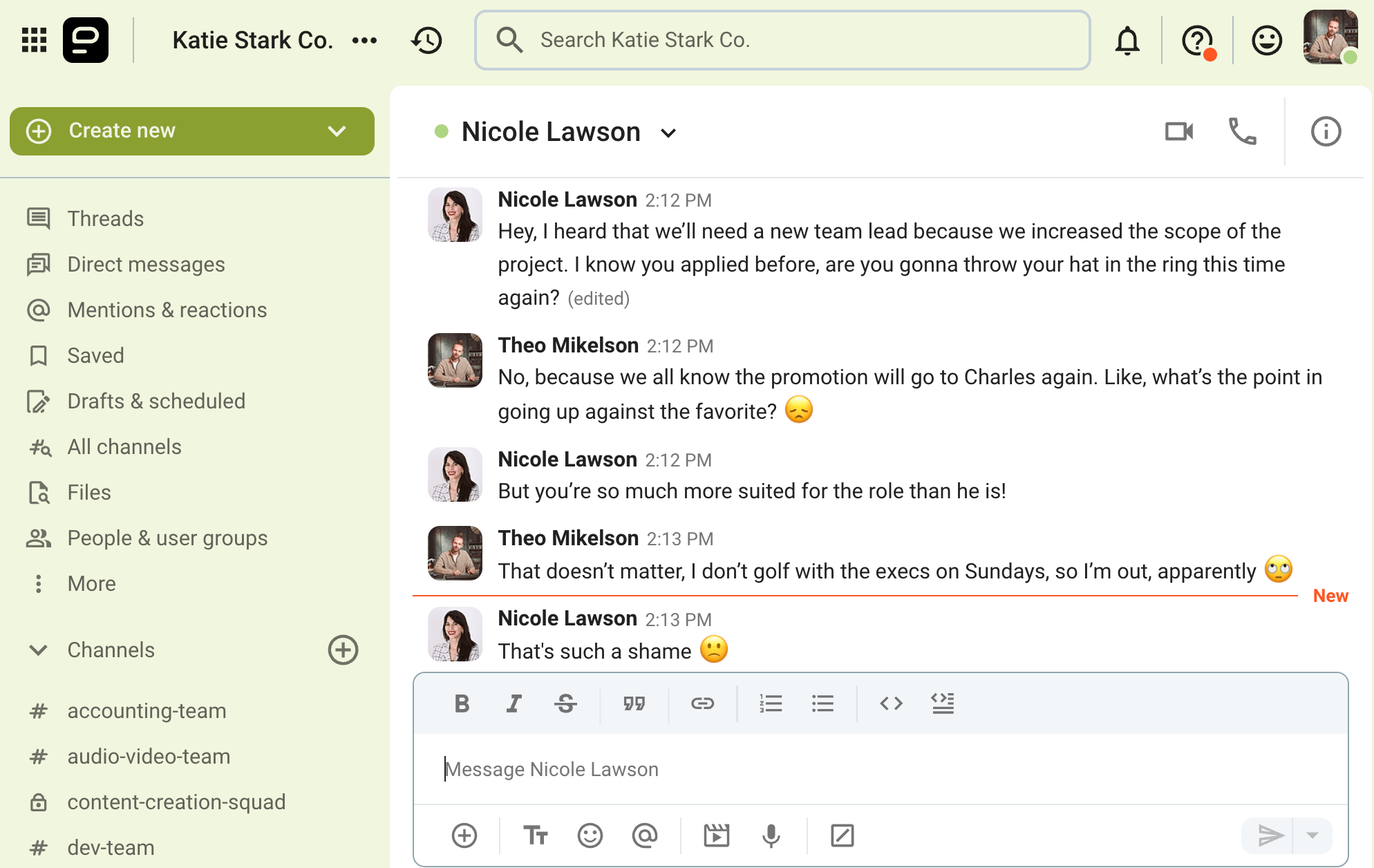
Empower communication and collaboration with Pumble
💡 Pumble Pro Tip
If you’re looking to boost the morale of your employees, start by eliminating favoritism from the workplace. After that, try employing one (or more) of the tips from the post below:
Low productivity
As we mentioned before, all effects of favoritism at work stem from one another. So, if you aren’t motivated to do your work, you probably won’t be very productive either.
As Dovile Gelcinskaite, Senior Talent Manager, told us, this is an expected turn of events:

“When someone is favored in the workplace, others usually feel overlooked. Over time, they may stop putting in effort because they know it won’t get noticed.”
It’s important to keep in mind that poor performance and low productivity are direct results of favoritism in the workplace because engagement and productivity are very closely connected.
According to Pumble’s Employee Engagement Statistics, 92% of executives believe their employees perform better when they are engaged. What’s more, 56% of them claim employee engagement directly impacts profits.
Conflict and resentment
When your boss passes you over for a promotion (again!) over his favorite employee, Susie, who are you going to be mad at? Your boss? Of course. But you’ll also be mad at Susie, won’t you?
That’s because favoritism at work breeds resentment at all levels.
Your relationship with Susie will become tainted, making working with her harder due to resentment.
Eventually, this will lead to poor team performance because of conflict.
Take a look at what favoritism can do to team dynamics, as shown in an exchange on Pumble, a team communication app.
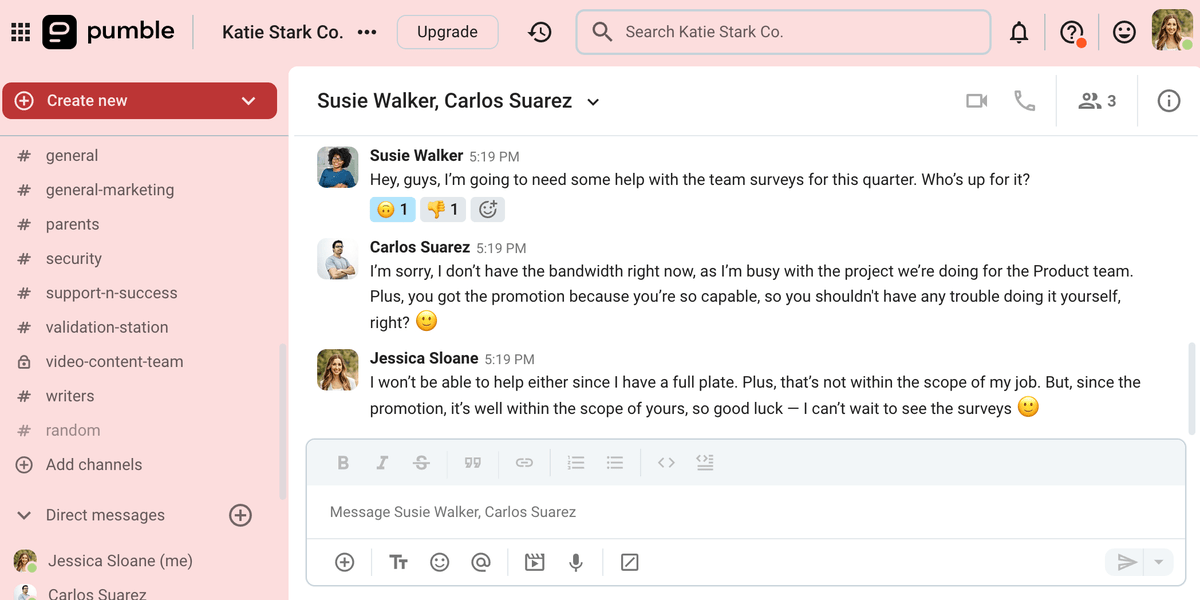
💡 Pumble Pro Tip
If the damage is done, and favoritism has already led to team conflict, you need to go into damage control mode as soon as possible. Here are the best tips for conflict resolution in teams:
Loss of trust and respect
Trust is crucial for any relationship, and it’s one of the signs of a positive company culture.
That’s why the most significant impact of favoritism in the workplace is loss of trust, as Sean Smith, CEO and former Head of HR, told us:

“The most damaging impact that favoritism has is on trust. If employees feel that decisions are made based on favoritism and not merit, they lose trust in the management’s capability of being fair and neutral. This lack of trust quickly trickles down into the rest of the team, creating an ‘us vs. them’ culture, which divides and disengages employees.”
As soon as employees start doubting the fairness and impartiality of their leadership, trust erodes and makes space for low morale, disengagement, and conflict.
High turnover
Finally, the last effect of favoritism in the workplace is high turnover. What else can you do once you’ve lost trust in the leadership, feel disengaged, and aren’t productive, except leave the company for better opportunities?
As we established, favoritism leads to a lack of engagement, and, according to Pumble’s Communication Statistics, engaged employees are 87% less likely to leave a company.
So, lack of engagement directly leads to high turnover — which means not only loss of talent but also diversity of thought, as our expert Edel Holliday-Quinn noted:

“Favoritism can increase turnover, with talented employees leaving for organizations where they feel more appreciated. Beyond morale, favoritism stifles diversity of thought, as overlooked employees may withhold their perspectives. For example, a talented team member might remain silent or leave if they see others consistently rewarded despite weaker contributions.”
Now that we know what favoritism is and what it can do to your organization, let’s see how you can prevent it or deal with it — both as an employee and as a manager.
How to deal with favoritism in the workplace: Employee perspective
Favoritism at work is a systemic problem — one employee can’t eradicate it.
However, that doesn’t mean you can’t do anything about it.
If you’re being unfairly favored at work, you need to speak up against it — even when it hurts your chances for career advancement. Be sure to respectfully communicate your concerns with the higher-ups and back them up with evidence, as Edel Holliday-Quinn advises:

“Document specific incidents, including dates and examples of unequal treatment, to establish a clear record. Open, respectful communication with managers is also essential — approaching these conversations constructively can help address the issue without causing unnecessary conflict.”
Here’s an example of what that conversation might look like.
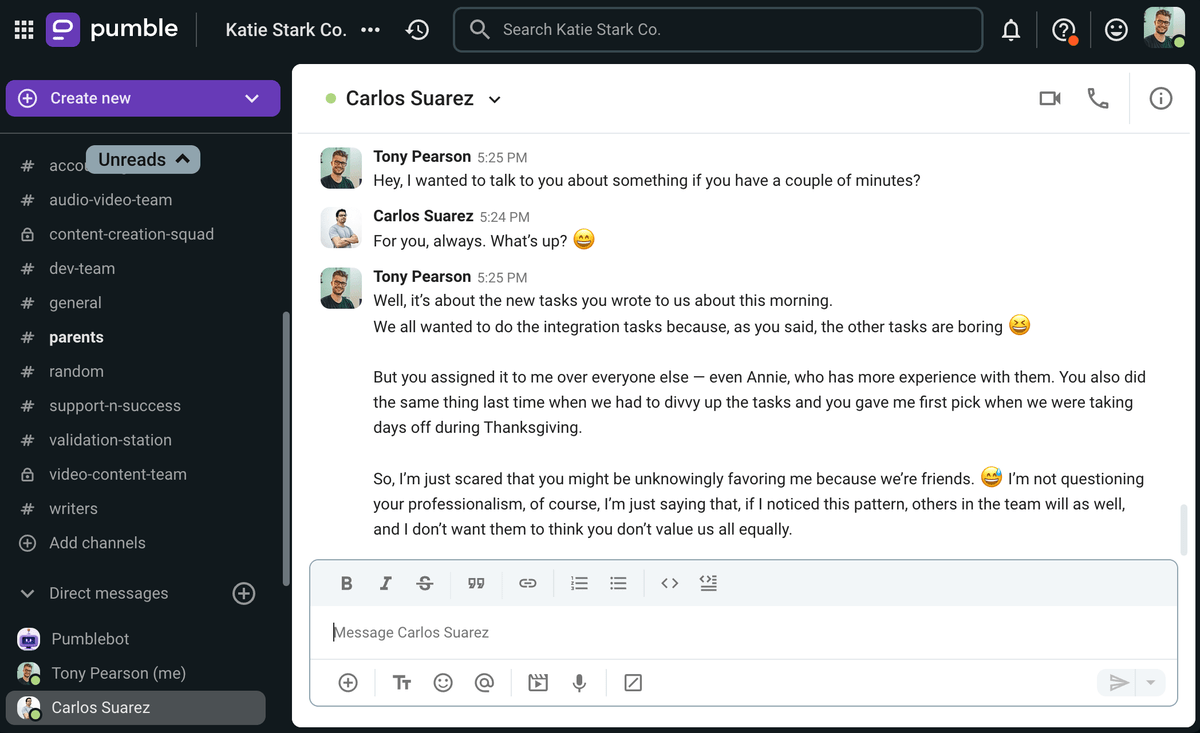
Resolve issues quickly and efficiently over Pumble
If you notice favoritism or it affects you negatively (namely, if you’re not the person being favored), there are a few things you can do.
Firstly, you can focus on the things you can control — such as your skills. Focus on yourself and work on your skills that will help you get noticed.
But, don’t just aim to get noticed by your direct manager. Instead, branch out and network, as our contributor Eva Chan advises:

“Keep performing at your best, building your skills, and staying professional — it shows you’re dedicated, no matter the situation. At the same time, work on building good relationships with others across the team and leadership. This way, your contributions don’t just depend on the view of one manager — they’re noticed by a wider group.”
If you’re wondering how to complain about favoritism at work without sounding like a whiner, the solution is simple — be direct and don’t give up.
Raise the issue with your manager and, if necessary, include HR in the conversation, as Alisa Volynets advised:

“If you feel comfortable, try to be open with your manager about the need to evaluate your performance. The manager may not have been aware of the problem and may not have noticed that they are paying more attention to some employees. If the dialogue does not change the situation, contact the human resources department, because ignoring the difficulty of favoritism can lead to team disputes.”
So, sometimes even just opening a discussion about favoritism with your manager will be enough to stop it from happening, as seen you can see in the example below.
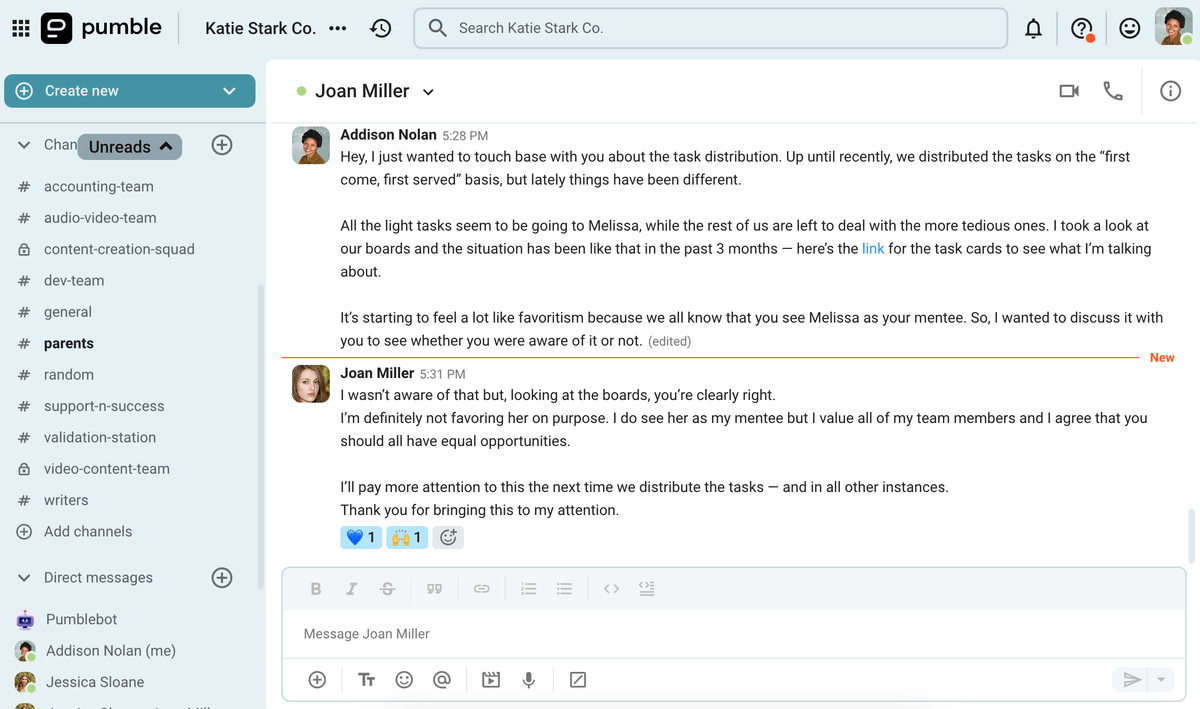
How to handle favoritism in the workplace: Manager perspective
Managers can do a lot when it comes to dealing with favoritism in the workplace — quite a bit more than individual employees.
Here are the 7 best tips for managers on how to prevent and deal with favoritism in their teams:
- Use skill-based and structured interviews when hiring new personnel.
- Use transparent and fair promotion criteria to ensure equal opportunities for everyone.
- Clearly communicate all decisions as well as factors that contributed to them.
- Make space for relationship building between managers and leaders and all employees.
- Encourage teamwork and create a collaborative environment.
- Provide employees with training and resources on recognizing and reporting favoritism in the workplace.
- Provide leadership training to managers that will help them recognize, investigate, and act on favoritism.
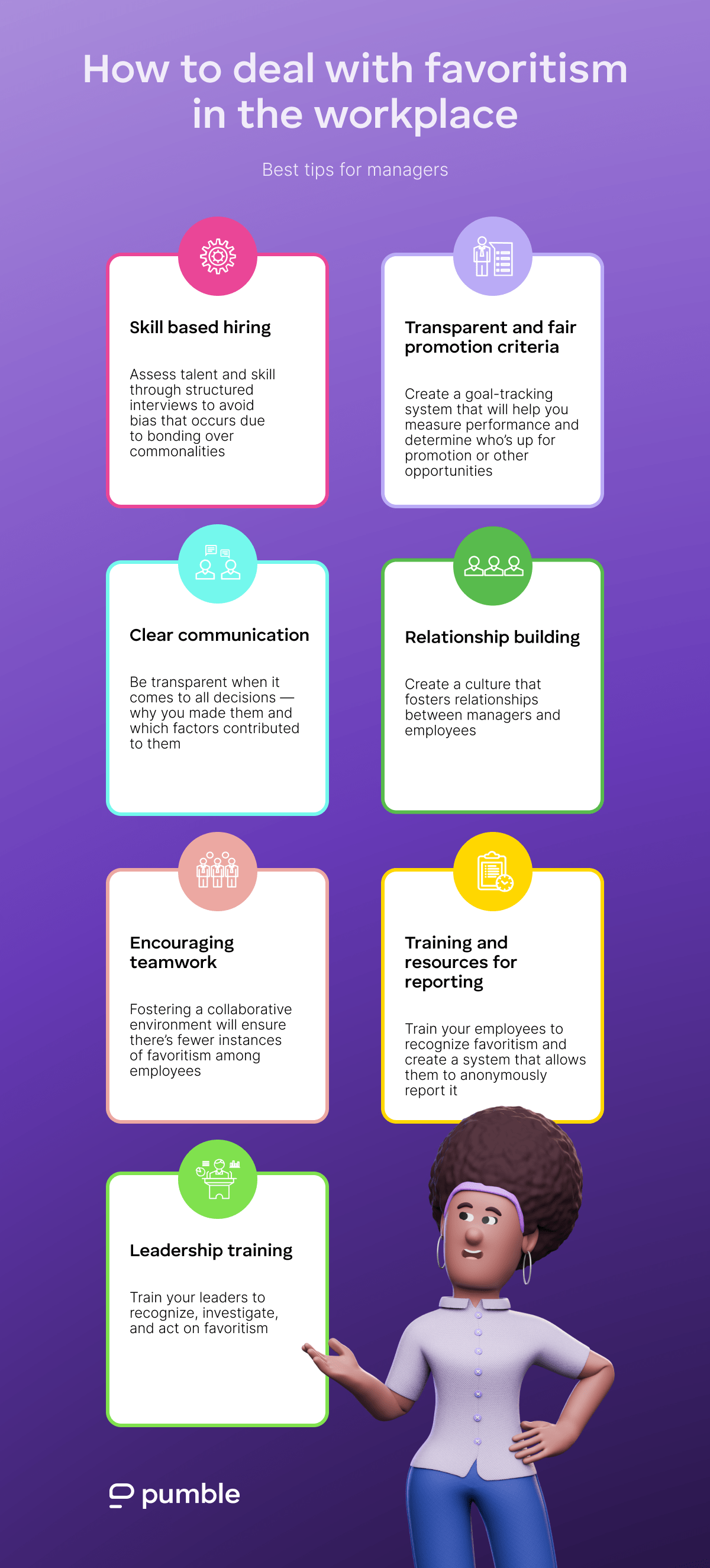
Now that we have a rough idea of what managers can do to prevent and stop favoritism at work, let’s take a deeper look into each point — and see what tips our experts had to share with us.
Tip #1: Employ skill-based hiring processes and structured interviews
The best thing you can do to deal with favoritism is to ensure there isn’t any.
A tall order, we know, but you can nip favoritism in the bud at the very start — the hiring process.
Rather than employing people who you think will be a “good fit” personality-wise, it’s better to assess applicants’ talent and skill through structured interviews. That way, you’ll be able to avoid bias that occurs due to bonding over commonalities.
By assessing talent, you’ll be able to objectively rule when it comes to hiring (and, later, promotions and other growth opportunities). According to some studies, talent assessment can mitigate the effect of bias and reduce mis-hires by 90%.
Tip #2: Establish transparent and fair promotion criteria and policies
It’s essential that your employees perceive you as fair. Studies on workplace favoritism and employee well-being show that perceived leadership favoritism negatively impacts:
- Job satisfaction,
- Organizational commitment, and
- Group identity.
So, being seen as an unfair manager or leader can greatly affect your team’s dynamic and become an obstacle to collaboration and productivity.
To ensure there’s fairness in the workplace, you need to reward and recognize your employees based on merit.
You can do that by creating a goal-tracking system that will help you measure performance and determine who’s up for promotion or other opportunities. But, make sure your system is fair, as Eva Chan advises:

“It’s important to use clear, objective criteria when deciding on promotions, rewards, or key projects. When you’re transparent about these decisions, it goes a long way in building trust.”
Creating a fair system ensures your employees feel seen, heard, and, most importantly, valued — which is more important in the long run than being liked:

“While being liked is undeniably an important aspect of professional relationships, it’s critical to separate personal preferences from workplace equity. By communicating transparently and keeping themselves and their direct reports accountable, managers can ensure that every employee feels valued, and success becomes about merit rather than favoritism.”
Make sure your employees also have access to the criteria, so they always know what’s expected of them.
If you use a team collaboration app like Pumble, it can serve as your digital HQ — you can use specific channels as hubs of information that your employees can always go back to when they need to.
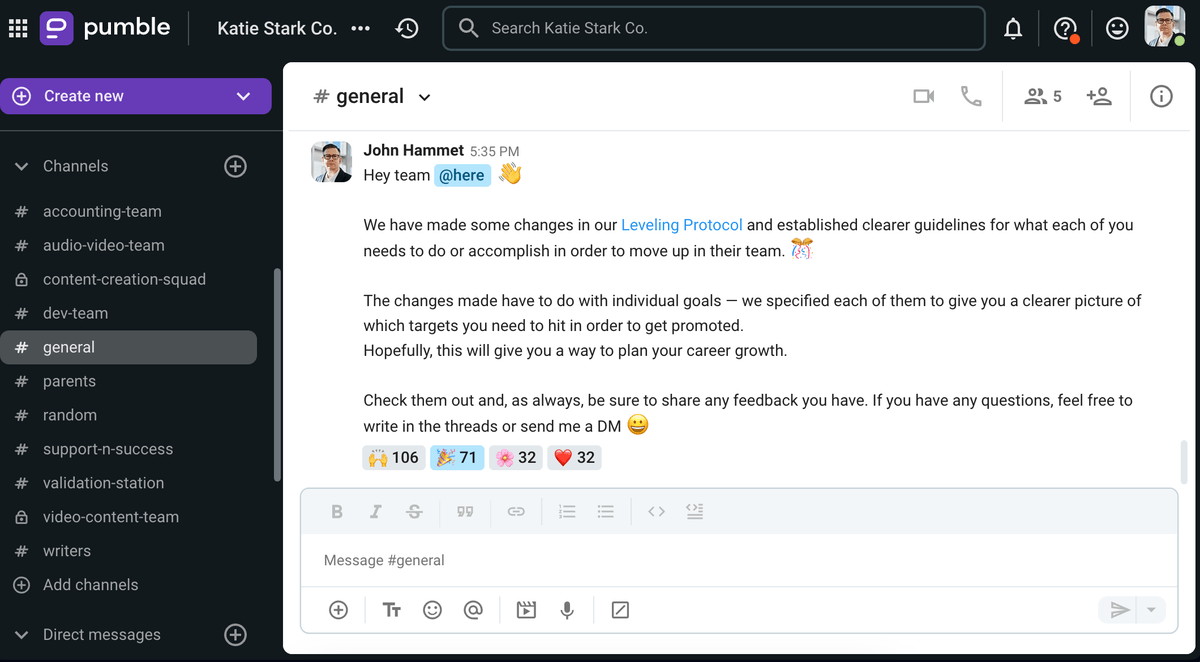
Tip #3: Use clear communication
All the fair criteria that you’ve meticulously come up with to ensure fairness in your team won’t mean much if your team members aren’t aware of them.
So, make sure to clearly communicate all criteria as well as promotion and reward policies to everyone.
Be transparent about all decisions — why you made them and which factors contributed to them. That way, your employees will know all your decisions are objective (and not based on favoritism).
Also, make sure to always give constructive feedback to your employees — and ask for it, as Sean Smith advises:

“Feedback is key. Ask your employees what they think about fairness in the workplace. Team members should be encouraged to provide input on fairness at work through anonymous surveys or one-on-one discussions. Alleviate favoritism fears immediately and as openly as you can.”
Being clear creates a communication-first culture in your team — where your employees feel they can voice their opinions and trust you to share important information with them — which fosters trust and, ultimately, helps you battle favoritism in the workplace.
💡 Pumble Pro Tip
Unclear communication is one of the worst habits you can demonstrate — both as a manager and employee. To find out what other bad communication habits might be holding you back (and find out how to break them), read the following blog:
Tip #4: Encourage relationship building
Favoritism at work is often a consequence of the proximity bias.
We see an employee exhibiting similar interests or behavior as us and we instantly like them. Because we like them, we tend to spend more time with them, and, when the time comes to give someone an opportunity or promotion, who do we think of? Our buddy, of course.
One way to go around this is to ensure you build a relationship with all employees — not just the ones you instantly liked, as Eva Chan noted:

“Try to give all your team members equal attention. Make an effort to spend time mentoring and supporting everyone, not just a select few.”
Creating a culture of relationship building also helps battle peer favoritism, as it ensures that team members bond with each other.
One of the best ways to ensure you get enough bonding time with all your team members is to purposefully set aside time for it. Set up one-on-one meetings with everyone, weekly check-ins for the whole team, as well as some time for group bonding.
Even virtual team-building games can help your team members become closer and more connected.
You can use your employee communication app to connect with your team every week (or even every month) to play a game and build a deeper relationship.
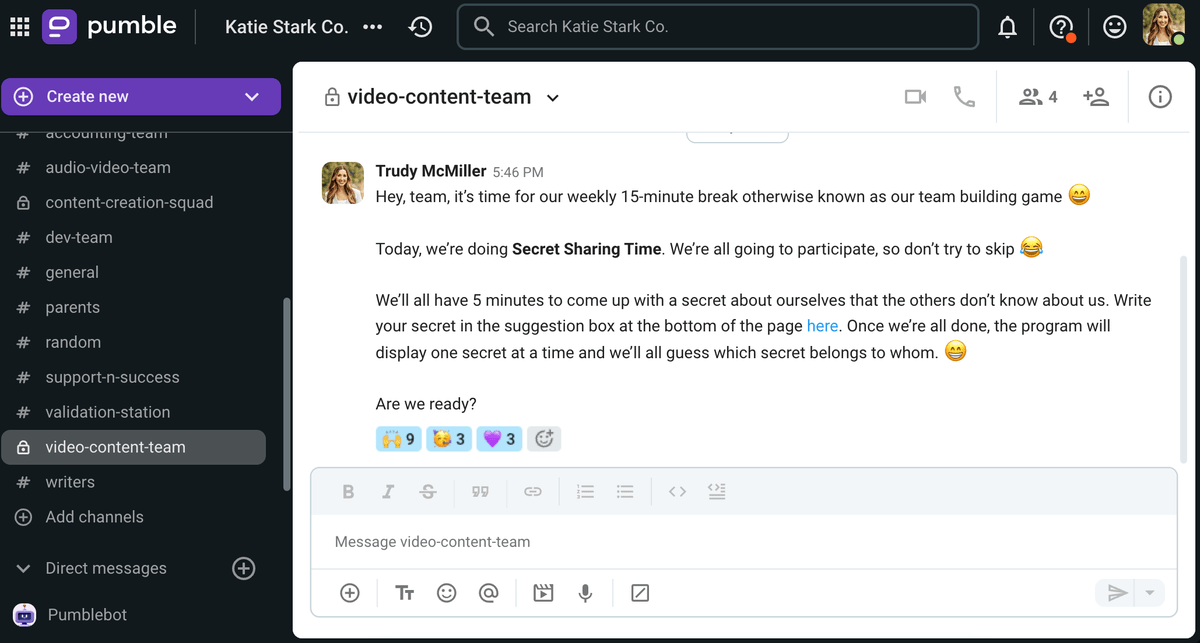
Build trust and connections in your team over Pumble
Tip #5: Foster teamwork and collaboration
One of the fringe benefits of ensuring your team members bond with each other is that bonding fosters teamwork and collaboration.
Ensuring your employees form ties to each other:
- Boosts innovation,
- Encourages open-mindedness, and
- Deepens the relationship between employees.
This makes it less likely that you’ll witness the rise of a social hierarchy within the team — and, thus, less likely that you’ll have to deal with cliques and bullying in the workplace.
In other words, nurturing a collaborative environment will minimize favoritism among employees.
Tip #6: Offer training and resources for reporting
To prevent favoritism, you need to be on the lookout for it.
But, sadly, you can’t really see everything — especially your own bias.
That’s why one of the more vital steps in your battle against favoritism in the workplace is to train your employees to recognize favoritism and empower them to report it.
By employing one of our earlier tips — to communicate clearly — you should have established a psychologically safe environment where your employees feel safe to report favoritism when they see it.
Now all you have to do is create a system that allows them to report it.
Edel Holliday-Quinn advises the use of surveys:

“Encouraging regular feedback through surveys or one-on-one check-ins can help managers identify and correct perceptions of favoritism early.”
Tip #7: Offer leadership training
If you’re unsure whether you or your fellow managers can spot favoritism (especially in yourselves), don’t worry — you can learn.
In fact, training managers to recognize favoritism in the workplace is another great piece of advice Edel Holliday-Quinn had for us:

“Providing training on unconscious bias can help leaders recognize and address favoritism, even when it’s unintended.”
You need to train your leaders to recognize, investigate, and act on favoritism — none of which is easy.
Our contributor, Sean Smith, agrees — it’s not easy, but it’s necessary:

“Training is another essential part [of dealing with favoritism]. Managers require training on unconscious bias and the ramifications it has on decision making. For example, leaders will inevitably connect more with certain employees than others — this, however, cannot happen at the expense of equality.”
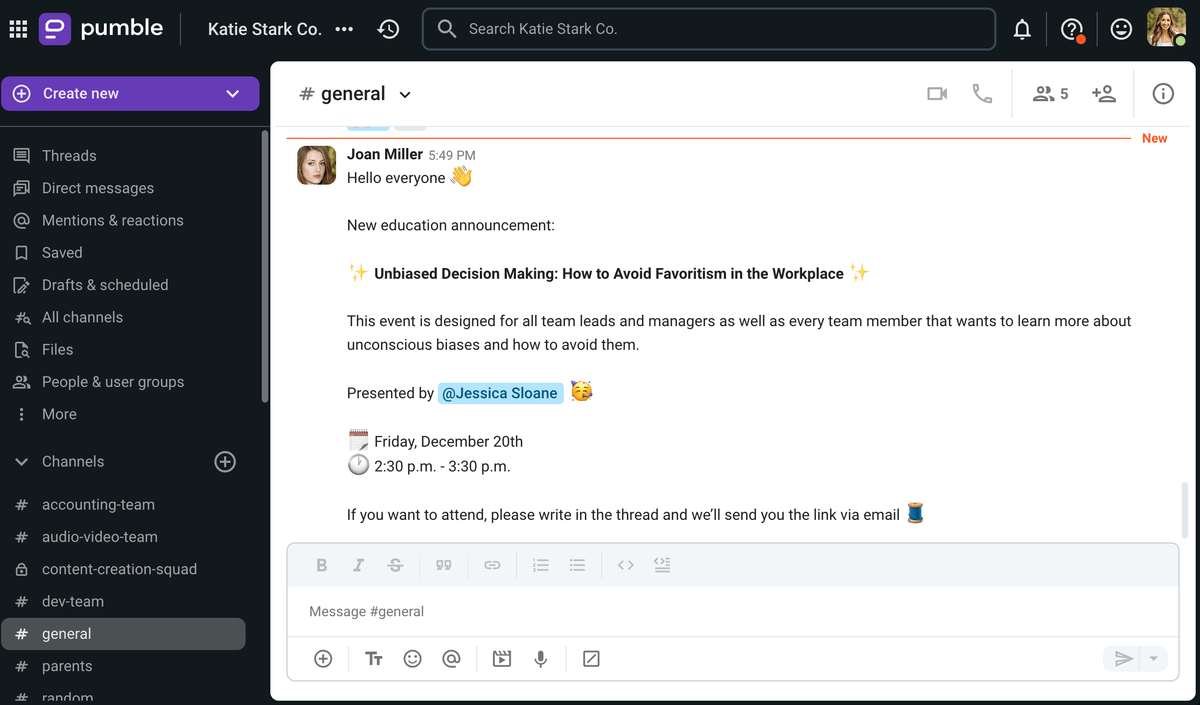
Promote transparency and prevent favoritism with Pumble
Aside from knowing how to deal with favoritism in the workplace, it’s also important to apply the right tools.
Pumble, an all-in-one communication solution, can help you follow some of our tips and, ultimately, be your best ally in your fight against favoritism at work.
With Pumble, you can:
- Create specific user groups to share information with all relevant employees and ensure no one feels left out,
- Keep all your important documents (like promotion criteria and employee expectation policies) in one place forever, thanks to unlimited history,
- Keep in touch with all your employees and ensure both one-on-one and group time with video conferencing, and
- Hold engaging workshops for your employees and managers and make them available to everyone who couldn’t attend thanks to meeting recording.
Easy to use, affordable, and user-centric, Pumble will ensure equity and transparency in both your team and team communication.
Eradicate favoritism in the workplace — try Pumble for free today!
